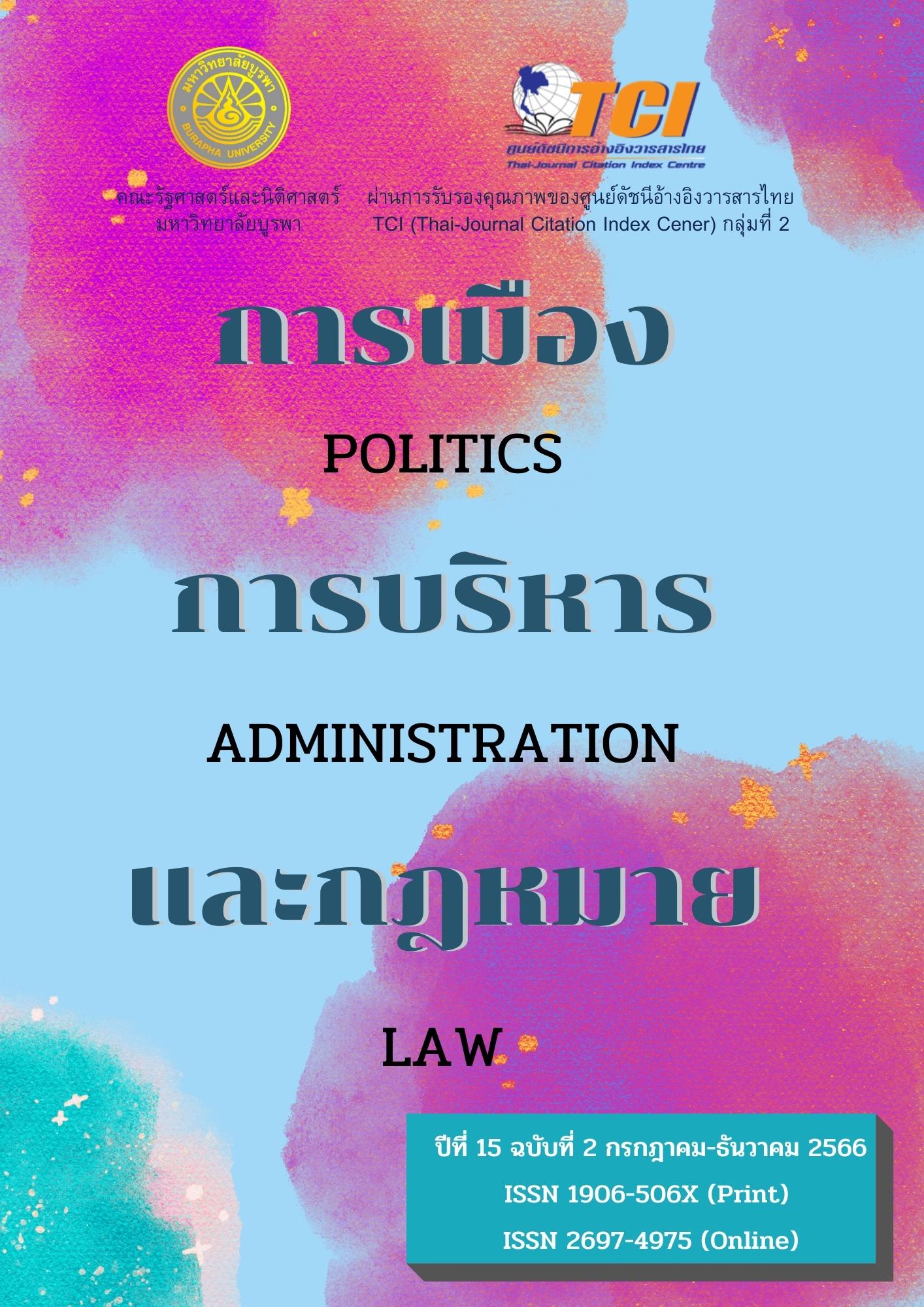Human Capital Social Capital and Organizational Effectiveness of Police Stations under Provincial Police Headquarters Region 1-9
Keywords:
Human capital, Social capital, Organizational effectivenessAbstract
The objectives of this study were; 1) to study the levels of human capital, social capital and organizational effectiveness of police stations under provincial police headquarters region 1-9., 2) to study the influence of human capital on organizational effectiveness of police stations under provincial police headquarters region 1-9., 3) to study the influence of social capital on organizational effectiveness of police stations under provincial police headquarters region 1-9. and 4) to study the influence of human capital and social capital on organizational effectiveness of police stations under provincial police headquarters region 1-9. The populations were 1,394 police stations. The samples were 301 police stations selected by multi-stage sampling technique. The respondents including 1,450 police officers from 290 police stations. The research instruments were 5 rating scales questionnaires. The data were analyzed using descriptive statistics and the inferential statistics. Structural Equation Modeling was applied as the analysis data method. The research result revealed that: 1) Human capital, social capital and organizational effectiveness of police stations under provincial police headquarters region 1-9 were at a high level. 2) Human capital had influenced statistically significant on organizational effectiveness of police stations under provincial police headquarters region 1-9. (γ = 0.776, p<.01) 3) Social capital had influenced statistically significant on organizational effectiveness of police stations under provincial police headquarters region 1-9 (γ = 0.214, p<.01) 4) Organizational effectiveness of police stations under provincial police headquarters region 1-9 was strongly influenced by human capital and social capital. (R2 = 0.881) In full model test, it described that the complete measurement fulfils the minimum required values of Goodness of-Fit (GoF) model which were mentioned respectively as follow: (χ2 = 820.427; df = 195; p-value = 0.067; χ2/df = 4.207; RMSEA = 0.217; 90% CI on RMSEA = 0.104; CFI= 0.945; NNFI (TLI) = 0.958; SRMR = 0.047)
References
ชนณรงค์ วันชา. (2560). รูปแบบการพัฒนาประสิทธิภาพตู้ยามตำรวจชุมชน(โคบัง) ในการป้องกันอาชญากรรมของตำรวจภูธรภาค 4. วารสารสันติศึกษาปริทรรศน์ มจร, 5(1), 211-224.
นัยนา เกิดวิชัย. (2554). การพัฒนาทุนทางสังคมของตำรวจไทย. วิทยานิพนธ์ปริญญาดุษฎีบัณฑิต, สาขาวิชารัฐประศาสนศาสตร์, คณะรัฐศาสตร์, มหาวิทยาลัยอุบลราชธานี.
พงษ์เทพ จันทสุวรรณ เอกรัตน์ ดวงปัญญา ชาญณรงค์ เศวตาภรณ์ และอนงนาฏ ภูมิภักดี. (2554). ภาวะผู้นำการเปลี่ยนแปลง วัฒนธรรมองค์การ องค์การแห่งการเรียนรู้และประสิทธิผลของหน่วยงานในสถานีตำรวจนครบาล: การวิเคราะห์เส้นทาง. วารสารร่มพฤกษ์, 30(1), 89-116.
พิชญาฏา พิมพ์สิงห์. (2558). การศึกษาปัจจัยที่มีความสำคัญต่อการพัฒนาทุนมนุษย์ของบุคลากรสายวิชาการในมหาวิทยาลัยราชภัฏสุราษฎร์ธานี. วารสารบัณฑิตวิทยาลัย พิชญทรรศน์, 10(1), 45-54.
ลุบนา นิยมเดชา. (2565). การพัฒนาทรัพยากรมนุษย์และการพัฒนาทุนมนุษย์ที่ส่งผลต่อประสิทธิผลองค์การบริษัทเอก-ชัย ดิสทริบิวชั่น จำกัด สาขาสามกอง จังหวัดภูเก็ต. HRM NPST National Conference 2022, 391-404.
วิเชียร จันทะเนตร. (2563). ทุนทางสังคมและวัฒนธรรมองค์การ กับประสิทธิผลขององค์กรปกครองส่วนท้องถิ่น. วิทยานิพนธ์ปริญญาดุษฎีบัณฑิต, สาขาวิชารัฐประศาสนศาสตร์, คณะศิลปะศาสตร์, มหาวิทยาลัยเกริก.
ศรีสกุล เจริญศรี. (2562). ธรรมาภิบาล วัฒนธรรมองค์การ กับประสิทธิผลองค์การ ของหน่วยงานในสังกัดสำนักงานผู้บัญชาการตำรวจแห่งชาติ. วิทยานิพนธ์ปรัชญาดุษฎีบัณฑิต สาขาวิชารัฐประศาสนศาสตร์ วิทยาลัยบัณฑิตศึกษาด้านการจัดการ มหาวิทยาลัยศรีปทุม.
สกนธ์ ดำสาคร. (2562). การพัฒนาทุนมนุษย์ของกองบัญชาการในสังกัดสำนักงานผู้บัญชาการตำรวจแห่งชาติ. วารสารสหวิทยาการวิจัย: ฉบับบัณฑิตศึกษา, 8(1), 72-84.
สำนักงานตำรวจแห่งชาติ. (2564). แนวทางการปฏิบัติงานตามนโยบายการบริหารราชการสำนักงานตำรวจแห่งชาติ ประจำปีงบประมาณ พ.ศ. 2563. สืบค้นข้อมูลเมื่อวันที่ 15 ธันวาคม 2564, เข้าถึงได้จาก http://www.royalthaipolice.go.th/
อกนิษฐ ด่านพิทักษ์ศาสน์ อติพร เกิดเรือง และประยุทธ์ สวัสดิ์เรียวกุล. (2564). แนวทางการพัฒนาข้าราชการตำรวจภูธรจังหวัดภูเก็ต ยุคไทยแลนด์ 4.0. วารสารวิชาการ สถาบันวิทยาการจัดการแห่งแปซิฟิค, 7(1), 298-306.
อุษณี มงคลพิทักษ์สุข. (2560). วัฒนธรรมองค์กรปกครองส่วนท้องถิ่น ยุคไทยแลนด์ 4.0. วารสารร่มพฤกษ์, 35(2), 141-162.
Bateman, S. T., & Snell, A. S. (2009). Management: Leading & collaborating in a competitive world. Boston, Mass: McGraw-Hill/Irwin.
Bovee, C. L., et al. (1993). Management. New York: McGraw-Hill.
Bryant, Cindy-Ann & Norris, Cindy-Ann. (2002). Measurement of social capital: The Canadian experience. Prepared as a country report for the OECD – UK ONS International Conference on Social Capital Measurement in London, 25-27 September 2002.
Coleman, J. (1988). Social capital in the creation of human capital. American Journal of Sociology, 94, 95-120.
Davenport, T. O. (1999). Human capital: What it is and why people invest it. San Francisco: Jossey-Bass.
Diamantopoulos, A., & Siguaw, J. A. (2000). Introducing LISREL: A guide for the uninitiated. Thousand Oaks, CA: Sage.
Felicio, J. A., Couto, E., & Caiado, J. (2014). Human capital, social capital and organizational performance. Management Decision, 52(2), 350-364.
Gimeno, J., Folta, T., Cooper, A., & Woo, C. (1997). Survival of the fittest? Entrepreneurial human capital and the persistence of underperforming firms. Administrative Science Quarterly, 42, 750-783.
Hatch, J., & Zweig, J. (2000). What is the stuff of an entrepreneur?. Ivey Business Journal, 65(2), 68-72.
Holmes-Smith, P. (2001). Introduction to structural equation modeling using LISREL. Perth: ACSPRI-Winter Training Program.
Kooreman, P., & Wunderink, S. (1996). The economic of household behavior. New York: Martins Press.
Ostrom, E. (2000). Collective action and the evolution of social norms. Journal of Economic Perspectives, 14(3), 137-158.
Parviz Ahmad Valalizadah. (2019). Social capital, human capital and performance of traditional clusters of MSEsA: Case study of Herat City, Afghanistan. Retrieved November 12, 2022, from https://www.semanticscholar.org/paper/Social-Capital-%2C-Human-Capital-and-Performance-of-%3A-VALIZADAH/. 2016
Putnam, R. D. (1993). The prosperous community: Social capital and public life. The American Prospect, 4(13), 35-42.
Quinn, R. E., & Rohrbaugh, J. (1983). A spatial model of effectiveness criteria: Towards a competing values approach to organizational analysis. Management Science, 29(3), 363-377.
Ritzer, G., & Goodman, D. J. (2003). Sociological theory. New York: McGraw-Hill.
Snell, S. A., & Dean, J. W. (1992). Integrated manufacturing and human resource management: A human capital perspective. Academy of Management Journal, 35(3), 467-504.
Song, Jung Hyun. (2016). The effect of social capital on organizational performance in different cultures: A cross-national comparison of the United States and South Korea. Florida International University. FIU Electronic Theses and Dissertations. 2613. Retrieved November 12, 2022, from http://digitalcommons.fiu.edu/etd/2613
Wiklund, J., & Shepherd, D. (2005). Entrepreneurial orientation and small business performance: A configurationally approach. Journal of Business Venturing, 20(1), 71–90.
Youndt, M. A., & Snell, S. A. (2004). Human resource configurations, intellectual capital, and organizational performance. Journal of Managerial Issues, 16, 337-360.
Downloads
Published
Issue
Section
License

This work is licensed under a Creative Commons Attribution-NonCommercial-NoDerivatives 4.0 International License.






